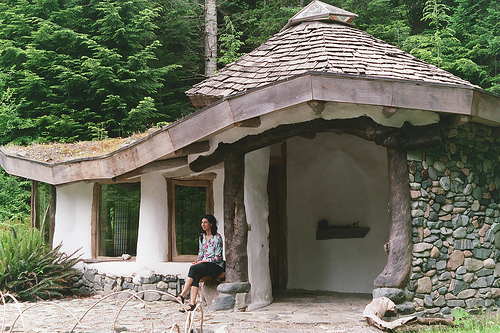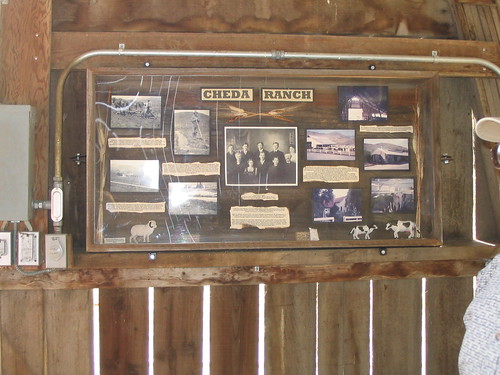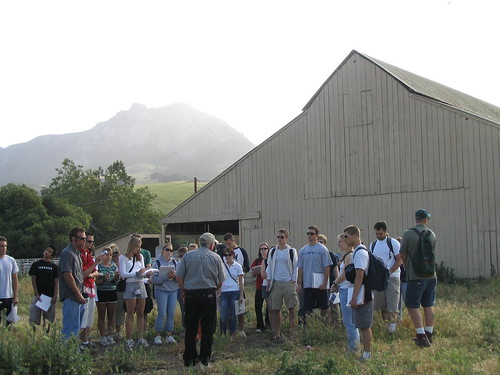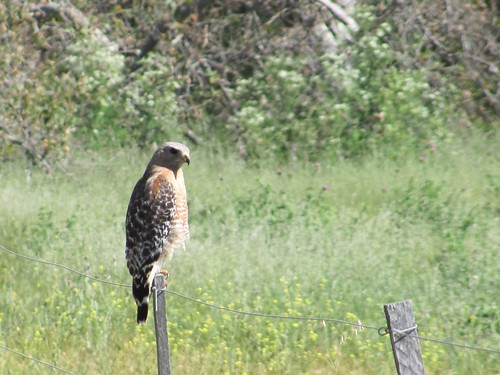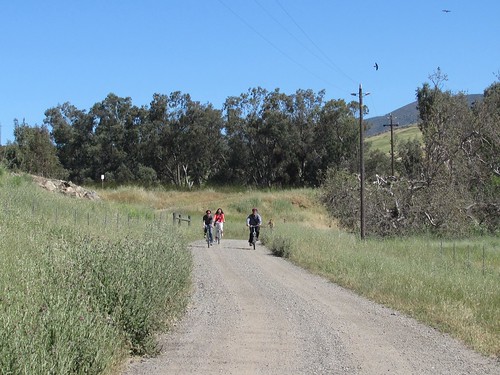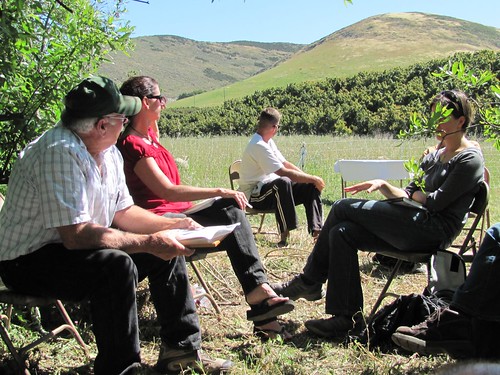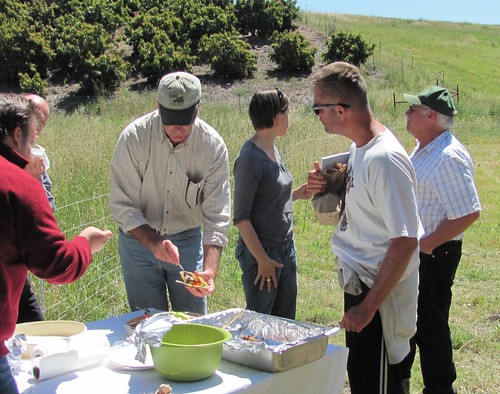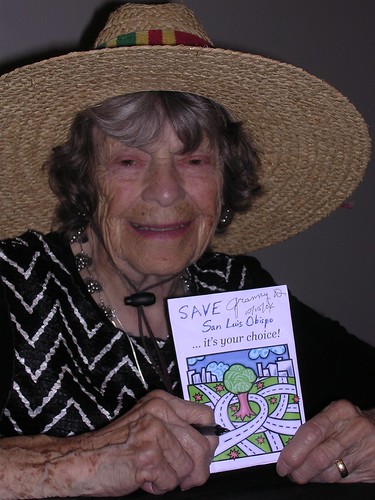Crossing Paths
Saturday, August 4th, 2012Solo departure for Lund at 7:00 A.M. after tying up loose ends yesterday, including the resubmission of a reformatted version of “Genes and Genesis,” the article now rejected by five journals. Jan cancelled her trip to stay in SLO because of late-breaking family developments.
Between Paso and Salinas, at the outset of the long drive I listen to the podcast of one of Dan’s Dharma talks, calmed by his voice though skeptical about the comprehensive reassurance he offers on all fronts, spiritual, emotional and political. Then the Beethoven Rasoumovksy quartets bubble in my earbuds as the wheels spin up the freeway at 80 mph. Then This American Life, Science Friday and Fresh Air. Despite disdain for Corporate Takeover, I’m grateful for what I get from the automobile, petroleum, and digital entertainment industries.
An hour before Davis, where I’ve arranged to have lunch with Caesar and Penny, my new iPhone dingalings to interrupt the podcast with a call from Chad, a former Cal Poly student organizer and political collaborator since 2007. He and Megan have taken a day off from their five month hike on the Pacific Crest Trail in Mt. Shasta City and he just wanted to say hello and thank-you for Jan’s email to him. I’ve read their endearing blog, Trail 4 Two, and have thought of them wistfully since they started back in April.
I’ll be in Shasta City that evening. Could we meet? I’ll get them a hotel room. He’s incredulous and hesitant. They just had a night in a hotel and are getting back on the trail to keep to schedule. Maybe we could meet, with further prearrangement, on my way back around the 22nd. I say I don’t want to pressure them of course, but what a coincidence this is. He needs to talk to Megan; they’ve just got a hitchhike ride to Castle Crags where they’ll rejoin the trail. I know Castle Crags I say; see it from the freeway every year for the last 42 years. He asks if I have camping gear and whether I could I meet them on the trail. Absolutely. He says he’ll phone back. A half hour later he does; says there’s a little road at the Centralia exit that leads to a spur where they can wait for me and we can hike and camp together tonight.
Caesar bubbles with news of his second grandchild born ten days ago and cooks up a fritata filled with his own garden’s vegetables. By 1:30 I’m eager to get back on the road for the rendezvous at Castle Crags. In our phone conversation I came up with between 4:30 and 5:00 out of the air, having little idea how long it would take from Davis, but as the hot Central Valley rolls by, the hour looks plausible. Chad emails the number of the ranger which I can miraculously click on the iphone, and he gives me the specifics of the location. Then there’s a sign about traffic delays due to a fire ahead, and just above Lake Shasta the smoke and the slowed traffic that might abort the meeting.
[flickr id=”7707454128″ thumbnail=”medium” overlay=”true” size=”medium” group=”” align=”left”]
But the delay is brief and at the Dog Trail parking area, Chad and Megan are sitting under a tree. We embrace and marvel at the coincidence of our trajectory. I load my backpack with sleeping bag and the bread and sardines Jan had sent along and we head up toward Castle Crags and the maintrail.
[flickr id=”7707443796″ thumbnail=”medium” overlay=”true” size=”medium” group=”” align=”left”]
They are concerned about whether the climb is too steep, but I keep up the pace talking the whole way along the mercifully shaded path. It was 110 in Redding that afternoon, while they carried their 35 pound packs for hours through large changes in elevation. They brim with adventures on the trail and are curious about SLO politics and our family drama.
Around 7 we encounter some of their fellow PCT hikers setting up camps along a stream in deep shade.
[flickr id=”7707446180″ thumbnail=”medium” overlay=”true” size=”medium” group=”” align=”left”]
We find our own flat spot and are soon joined by “Fall Risk” a veteran of the Appalachian Trail. He hikes in special shoes that partially compensate for an orthopedic defect. Among many other roles he’s a musician and composer and has been producing fully mixed songs with a phone app and sending them to his girlfriend.
[flickr id=”7707437240″ thumbnail=”medium” overlay=”true” size=”medium” group=”” align=”left”]
Chad and Megan prepare a sumptuous dinner using vegetables they dehydrated before their trip, one example of the vast project of planning and preparation it required.
[flickr id=”7707444538″ thumbnail=”medium” overlay=”true” size=”medium” group=”” align=”left”]
Another is the coordination with “Trail Angels” who’ve met them along the way with luxury provisions and fresh company. But despite the totally upbeat atmosphere of our brief encounter I imagine that this project has involved a great deal of endurance of both physical and emotional rigors.
Though I sleep fitfully, the night is most pleasant lying next to Megan, breathing the balmy evergreen scented air, gazing at patches of light from the full moon sprinkled throughout the forest, reveling in the sense of escape from a burdensome routine of obligation and anxiety and the prospect ahead of staying at Knoll House and spending time alone with Joe and more time with him and his family.
We all awaken at dawn for an early departure to keep up our several travel schedules and catch up on the time time lost with this happy delay. The goodbyes are lengthy and poignant
[flickr id=”7707437846″ thumbnail=”medium” overlay=”true” size=”medium” group=”” align=”left”]
”better too brief than too long a visit. Along the trail I feel continued companionship with the moon and the crags
[flickr id=”7707439296″ thumbnail=”medium” overlay=”true” size=”medium” group=”” align=”left”]
[flickr id=”7707438906″ thumbnail=”medium” overlay=”true” size=”medium” group=”” align=”left”]
as I head back to the car concerned that it may have been vandalized by the locals who littered the parking area with shotgun shells and targets. But Jade waits intact, and I get back on the road, talk to Jan, listen to music and decide, a little recklessly, to take an alternate route to Portland, where I’ve arranged to meet Andy P. at his studio in the afternoon for coffee on the way to rendezvous with Joe that night somewhere close to the Canadian border.
The drive to Klamath Falls on route 97 through volcano country and farmland is fast and beautiful, but the road gets ugly, busy and slow on the way to Bend and beyond. I listen to a lecture by a Harvard Medical School Professor on recurrent Glioblastoma, Steve’s condition. I phone Andy to postpone and then cancel our meeting, perhaps until the return trip, and hear from Joe that he was late in leaving Ketchum and wont get to Bellingham until 1:30 A.M. So I decide to kill some time, process and upload photos and eat dinner at the Timberline Lodge near the top of Mount Hood. It’s a beautiful stone and timbered structure built by the WPA, graced with with vast views, mountain flowers in full bloom and the summer snowfields of the summit. A walk on the heavily travelled trail in back leads to a sign indicating a junction with the PCT.
[flickr id=”7707452166″ thumbnail=”medium” overlay=”true” size=”medium” group=”” align=”none”]
Here, Chad and Megan will again cross my path, but only after several more weeks of toil and deprivation.
I drive down the shoulder of the mountain and rejoin Interstate 5 north of Portland and carrying on my musical and literary migration as night falls. I hear Librivox recordings chapters from John Muir’s 1915 Travels in Alaska describing the beauties of the Northwest, the charm and geology of Victoria, the splendors of the inside passage and Alaskan glaciers. At midnight I reach a rest area five miles south of the border from which we can make an early enough departure to avoid what will be lengthy delays at immigration and at the ferry at the beginning of this midsummer holiday weekend. I fall asleep behind a picnic table, and waking for a pee at 1:30 I see Joe’s truck parked next to Jade. I get up with the first light at 5:00 A.M. wake and embrace him, and we get through the border and onto the ferry with no wait. His truck is loaded full with construction tools.
We buy groceries in Powell River, arrive at Knoll House in the sunshine, sleep-deprived but satisfied, and gasp at the immaculate condition of the place left to us by Tai and Theo, hardly a trace of their possessions visible, and all the Marx family stuff placed exactly where we left it. Neatly stacked next to the half completed deck for the cabin is a pile of timbers cut from a tree near the driveway by Sam Richards. Peter and Margaret stop by with a big zucchini and an invitation to a 70th birthday party at Pam’s, but we politely decline.

